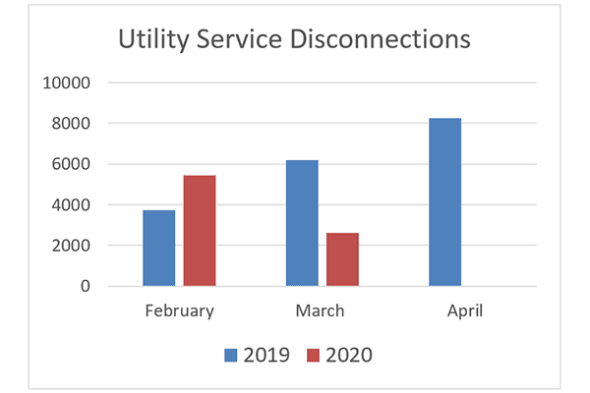Oregon Utility Service Shut-Off Moratorium: More Safeguards Needed
Posted on June 8, 2020 by Bob Jenks
Tags, Energy

In the middle of March 2020, regulated energy utilities in Oregon implemented moratoriums on service disconnections in response to growing economic concerns linked to the COVID-19 pandemic. CUB and many other groups urged the energy utilities to implement these shut-off moratoriums because Oregon’s Stay-At-Home order contributed to significant job losses, and turning off heat and lights would have been cruel and unfair to a rapidly growing number of households across the state.
We can track the impact of these shut-off moratoriums because Oregon is one of only a handful of states that requires regulated energy utilities to produce regular service disconnection reports. CUB was a key advocate behind this Public Utility Commission (PUC) rule, which was adopted in 2018.
The chart above shows disconnections in 2019 and through the first quarter of 2020. Disconnections fell by roughly 50 percent from February to March of this year, and no disconnections occurred in the month of April. In fact, there were 12,000 fewer disconnections in March and April of 2020 than during the same two months in 2019. This is important because March and April are the two months when disconnections typically hit their annual peak due to households falling behind on payments from energy-intensive winter months If Oregon energy utilities had not agreed to a moratorium on service disconnections, thousands of households would have lost their power or natural gas in the midst of a dire public health and economic crisis.
While thousands of residential customers have certainly benefited from the disconnection moratorium, more safeguards will be needed. Governor Brown declared a 60-day emergency on March 8 and later extended the emergency declaration to July 6. One energy utility has already suggested that when the emergency declaration ends, the moratorium will end as well.
CUB has serious concerns about this approach. The emergency declaration is linked to the state’s immediate public health response, but the economic impact of the COVID-19 pandemic seems likely to continue for months or even years into the future. Oregon’s unemployment rate is the highest it has been since the Great Depression and could continue to rise. Under these circumstances, ending the disconnection moratorium and sending thousands of shut-off notices in July is unjust and bad public policy.
Typical practice would be to allow customers to begin a payment plan to prevent their service from being terminated. If a customer can meet the terms of the payment plan and pay their current monthly bill, then their service will continue. But due to COVID-19, there may be thousands of households under severe financial stress who simply can’t pay their monthly bills, let alone make monthly payments on their debt.
CUB applauds energy utilities for implementing service disconnection moratoriums, but it is clear that Oregon cannot go back to business-as-usual anytime soon. More data is needed about arrearages (utility speak for unpaid bills), how many customers would likely be faced with service shut-off if moratoriums end, and availability of utility assistance funds. With broad stakeholder input, the PUC needs to develop new tools to facilitate customers’ management of their utility-related debt, including debt forgiveness options. No utility should be able to lift its moratorium without a plan that has been thoroughly vetted by stakeholders.
CUB is committed to advocating for Oregon’s most vulnerable utility customers, at all times, but especially now due to the COVID-19 pandemic still ravaging our nation and state.
To keep up with CUB, like us on Facebook and follow us on Twitter!




06/18/20 | 0 Comments | Oregon Utility Service Shut-Off Moratorium: More Safeguards Needed